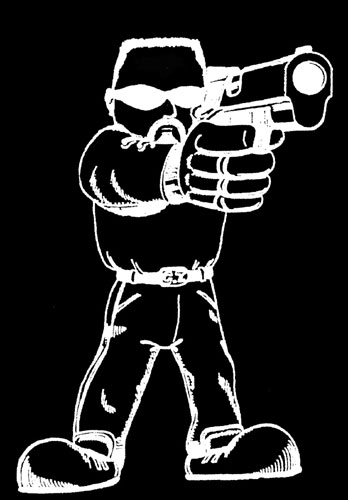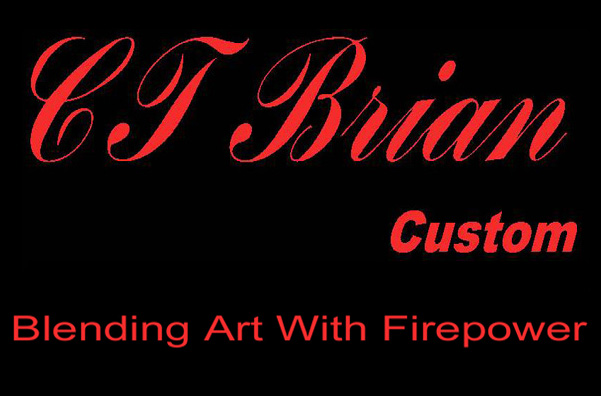

| Home | Greeting | Catalog | Magazine Articles | Photos | Links | Contact | Ordering |
| *The
CHOPPER |
* SideWinder |
Due to my current backlog, I am only accepting orders for full house customs.
By Peter T. Tomaras
Excerpts from AMERICAN HANDGUNNER - January/February 1989
Not everyone can afford full-race competition guns. Shooters with a hankering to try the action game choke at shelling out thousands of dollars for the basic tool. More than ever before, there’s a need for an affordable competition gun, and Tim Brian has addressed that need. His new Interphase compensator system, first marketed in 1988, makes the affordable competitive gun a possible dream.
To fully appreciate the Interphase, one must first understand the centerpiece of Brian’s work, his Phase III compensator system, which employs the principle of the parabolic curve in the expansion chamber. "Curving the interior of the expansion chamber with precision milling keeps gases flowing smoothly," he explains, "and I can more efficiently direct them where I want them to go."
The Phase III features a single port, which Brian prefers in effect and appearance to the dual ports he once used. It also incorporates a slightly longer exit hole to retain gases in the expansion chamber a tad longer-for more downward thrust.
Brian begins production of a Phase Three competition auto by shortening the slide one-half inch. The heart of any accurate auto is a match barrel, and Tim fits a Bar-Sto, Clark, Wilson, or Kart barrel to the action. He recuts the bushing relief because the muzzle end of the barrel is threaded for a half inch. He uses short, solid bushings which are rugged and produce optimum accuracy. They also function better than tapered cones with light PPC loads where there is no power factor.
Next he mills the compensator from 4140 steel. He drills and threads a one-half inch hole into it, and cuts the outside to exactly match the individual slide. He goes inside the slide and recuts the bushing locking lug hole. Then he fits a shortened full-length recoil spring guide system and an extended ejector. The finished compensated gun is just 1/2 inch longer than the standard Government Model.
With the port center-forward in the compensator, the front sight is dovetailed into the rear of the comp which butts up to within four one-thousandsths of an inch from the slide. Exquisite mating of comp to slide is a distinctive feature of Brian’s guns. Another is their perfect balance. His Phase Threes balance on a finger placed just ahead of the trigger.
Brian presently compensates only autos by Colt. Throw in the cost of the gun itself and the various other refinements a top competitor needs or wants and you investment gets substantial.
To make championship performance available to the budget-minded competitor, he combined the parabolic-curve expansion chamber of the Phase Three with a cost-saving exterior. The resultant godchild is the Interphase, the Phase Three.
The savings lies in less machine work; the slide is not shortened, and the compensator does not carry the design of the slide extended. A compromise in aesthetics, perhaps, but not in performance. The Interphase job includes a match barrel and an extended ejector.
Not cutting the slide allows the gunowner some interesting versatility. The front sight remains on the slide, which means the compensator and match barrel can be removed, and the original barrel dropped back in. The uncompensated gun can be used for duty, or for the stock gun class in IPSC matches. The shooter basically has two guns in one.
Overdosed on theory, I gathered up some guns and repaired to the range. I started off by firing a stock Gold Cup. Then I fired Phase Threes and Interphases with major loads, first in .45 ACP, then in .38 Super. Stairsteps to heaven. The reduction in muzzle flip and felt recoil was remarkable.
I was having too much fun to stop. Magazine after magazine, switching from one gun to another. Steel plates were falling, suddenly I was a better shot.
Brian’s .38 Super shot so sweet I changed my mind about buying a straight Interphase .45 for my first comp gun. Instead, I ordered the .45 plus a separate slide and barrel with integral feed ramp for the .38 Super. Now I can plink plates withte Super and switch over - in seconds - to a .45 and bowl over those pins. Two guns in one.
The competitor who wants to challenge for money or trophies, however, needs more than just the comp system. Brian’s Finalist package puts a complete competition pistol within the reach of the serious shooter of modest means. In addition to the Interphase compensator system, The Finalist includes: Bo-Mar adjustable sights; extended thumb safety; extractor adjusted; feed ramp polished and barrel throated; ejection port lowered and flared; competition trigger and trigger job with overtravel stop; Commander-style hammer; oversize mag release; mag well beveled; beavertail grip safety; Pachmayr flat mainspring housing; Pachmayr combat grips; and reblued slide.
Cost of the Finalist package is affordable. Little wonder the Finalist in the hottest item in Brian’s custom stable.
Hand checkering and custom finishing - deep blue or hard chromed - are cosmetic options. The hard-chrome, done in Berryville, Arkansas by Jim Kelley at Metaloy, gives a durable stainless-steel appearance. Brian takes great pride in his hand-polished, rich, dark blue, but believes black sights on a chromed edge gives fast shooters a split-second edge in getting their sight picture.
With Tim Brian’s metal serrating and checkering, it’s hard to draw the line between craft and art. In applying his considerable metalworking skills to utilitarian features, Brian attains the highest form of his pistolsmithing art.
At the client’s option, he’ll checker the front strap, the mainspring housing, the magazine release, and the trigger guard. He’ll mill flat and serrate the top of the slide, and checker or serrate the rear of it if you like. His hand-cut checkering ranges from 20 to 40 lines per inch depending on location.
The same ingenuity and care goes into Brian’s custom revolvers. He offers two packages for Model 10 Smith and Wessons: the PPC Custom and the Action Custom. The PPC begins with a competition-grade action job that delivers a smooth, 8-pound double-action pull. It features a Douglas premium bull barrel to which Brian fits a custom underlug. He chamfers the cylinder, recuts the forcing cone, and installs a ball crane lock for superior lock-up. He bobs the hammer, affixes a deluxe sight rib (Power Custom or Aristocrat), and adds Pachmayr grips.
The Action Custom, "the ultimate" for NRA Action/Bianchi competition, adds two things: the Douglas premium barrel comes with integral compensator, and this package includes optics. Brian presently uses the Jarvis mount and gives clients their choice of Aimpoint, Burris, or Tasco Scopes.